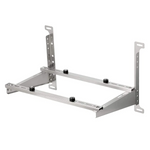
We’ve received a few questions about the BTU label changes for portable air conditioners. To help everyone out, we wanted to take some time to provide details about these changes and what they mean for your TOSOT portable air conditioner.
You probably noticed that the cooling capacity (in BTUs) of portable air conditioners have two ratings, one of which is lower than the other.
The label on portable air conditioners must follow a new rule from the FTC (Federal Trade Commission) that requires a listing of the older, ASHRAE rating, as well as a new rating from the DOE (Department of Energy.)
This new testing is meant to more accurately reflect the energy efficiency of all portable air conditioners, not just TOSOT units.
The reason for the difference in the two ratings is due to how a portable AC works. While our portable air conditioner does have a cooling capacity of 8,000 BTU under the ASHRAE rating, portable air conditioners must use some of the air inside your home to cool the internal components before blowing the now-hot air out through the exhaust hose.
This is an issue because the air that is blown out through the exhaust hose creates an air pressure vacuum that must be replaced with air from somewhere else.
The hot air that is blown out of the room is replaced by hot air from outside the room from various sources, such as air leaking in through the window, coming down from the attic, or through any cracks in the door. This means that the “adjusted” amount of cooling you get (i.e. the DOE standard) is lesser than the actual cooling capacity.
If you compare a window air conditioner to a portable unit, most of the internal components are already hanging out the window. This allows the window air conditioner to use outside air to cool down the internal components, meaning there is no adjustment on the cooling output for window units like there is with portable units.
Your portable air conditioner is still producing the same amount of cool air as a window air conditioner with a similar ASHRAE BTU rating. However, the adjusted cooling effect of a portable air conditioner may be lower due to the warm air that is pulled into the room as hot air is blown out of the exhaust tube of your portable unit.
Why do we use both BTU ratings on our products?
Although the construction and cooling capacity of our portable air conditioners remains the same, the new DOE testing standards require us to list the older ASHRAE testing results as well as the lower, adjusted number. If you do not see the older ASHRAE ratings, then that particular retailer is not in compliance with the new FTC rules.
---
Frequently Asked Questions?
Why would I pay more money for a unit with a lower cooling capacity?
It’s not actually a smaller unit. The design and internal components are mostly the same, but the testing conditions that determine the cooling capacity have been changed. This is why the FTC requires us to list both ratings on the unit.
Do I need to throw away or replace my old unit?
Not at all. The difference between the old and new units is insignificant. The only thing that really changes is the testing environment that the DOE uses to determine the cooling capacity of our portable air conditioners. Most of the internal components remain the same and the “real” cooling capacity that you feel is the same, just the way that it is classified is different.
If you have any additional questions about the two BTU ratings, please send an email to support@tosotdirect.com so a member of our support team can help you out!







2 comments
zmlnfzgkus - ¿Puede enviar un correo electrónico a supporttosotdirect.com?
Muchas gracias. ?Como puedo iniciar sesion?